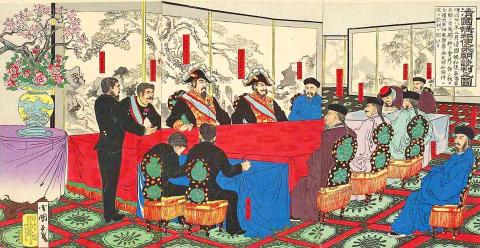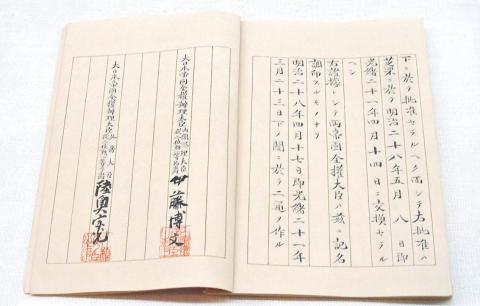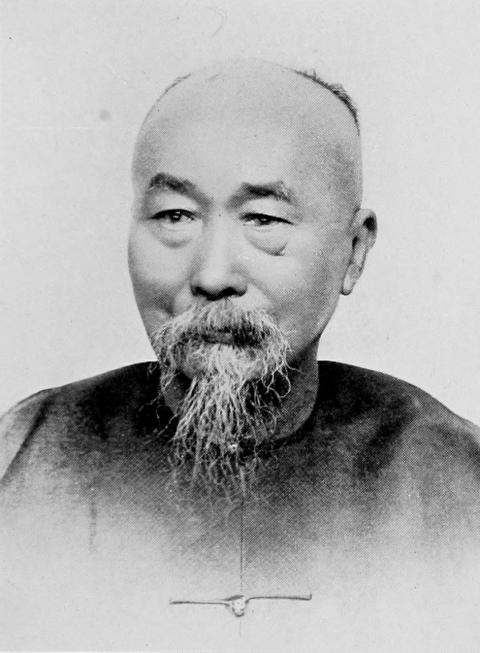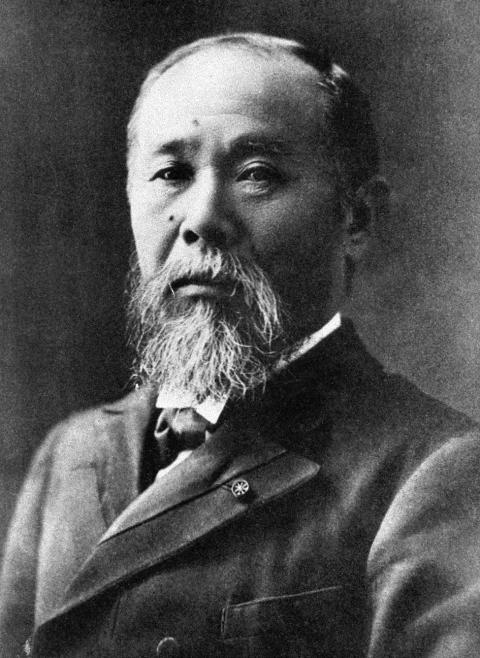April 17 to April 23
Just eight days after being shot in the cheek during an assassination attempt, Qing Dynasty official Li Hongzhang (李鴻章) emerged healthy enough for the first round of peace negotiations with the Empire of Japan at the tail end of the First Sino-Japanese War.
After about eight months of military conflict, the two sides signed a three-week armistice on March 30, 1895, with the Qing Empire as the clear loser. Over the next 18 days, Li and Japanese prime minister Ito Hirobumi met several times, finally signing the Treaty of Shimonoseki on April 17 — one of the conditions being that the Qing cede Taiwan and Penghu to Japan.

Photo courtesy of Wikimedia Commons
Despite opposition from Qing officials to the ceding of Taiwan, there was not much room for discussion. According to The Sino-Japanese War of 1894-95 by S.C.M. Paine, the armistice that the Japanese emperor offered did not include Taiwan and Penghu, and although Japan ceased its march on Beijing, it sent a force to Penghu on March 23 and swiftly occupied the entire archipelago before treaty negotiations began.
COVETED ISLANDS
Japan had long been interested in Taiwan because of its strategic location. As early as 1593, Toyotomi Hideyoshi sent an envoy to Taiwan to demand tribute, which was unsuccessful because there was no central government during that time. Talks of occupying Taiwan continued and intensified in the 1800s, with Westernization advocate Sato Nobuhiro proposing that Japan take Taiwan and use it as a base to assault China.

Photo courtesy of Wikimedia Commons
Taking Taiwan became an integral part of Japan’s expansion strategy after the Meiji Restoration. Plans were made long before the war began. In 1887, general Ogawa Mataji wrote, “Taiwan and Penghu are parts of the Qing Empire which many countries are drooling over … We must take these two islands. We shall heavily fortify them … and use them to control the central and southern provinces of the Qing Empire as well as a base for our southward expansion.”
These views were repeated by many politicians during the later stages of the war, several stating that if they did not capitalize on this victory to take Taiwan, it would almost certainly be swallowed up by a Western power. General Kawakami Soroku even advised Ito that agreeing to a ceasefire and obtaining Taiwan would prove far more valuable in 100 years than continuing the war and attacking Beijing.
Japan’s intentions were no secret. During the first meeting between Ito and Li on March 20, 1895 to discuss the ceasefire, Ito asked about the character of the people of Taiwan.

Photos courtesy of Wikimedia Commons
“Surely you mention this because you want to conquer Taiwan,” Li replied. “No wonder you don’t want to stop the war. But I’m sure that the UK would not just watch and let you occupy Taiwan.”
Ito replied that the matter was between Japan and the Qing, and third parties should not be considered.
“We’ve already made Taiwan a province, and there’s no way we will give it to another country,” Li stated. The Qing obviously had little clout in the negotiations as the losing side, and three days later, Japan attacked Penghu anyway.

Photos courtesy of Wikimedia Commons
Interestingly, according to A Study on Ming and Qing Policy Toward Taiwan (明清對台政策之研究) by Chen Chin-chang (陳錦昌), the Western powers were surprised at Japan’s decisive victory and changed their stance to supporting its demand for Taiwan.
THE NEGOTIATIONS
As expected, Japan immediately asked for Taiwan and Penghu during treaty negotiations. Since Japan requested both the Liaodong Peninsula in Northeast China and Taiwan, there was much debate in the Qing court about which one to give up if pressed.
Li tried to persuade Ito to only take Penghu on the grounds that Japan should only be entitled to territories it had already occupied. But Ito remained adamant. Li then offered Ito mining rights in Taiwan, while the Qing would keep the land and people. Ito threatened to resume war.
The Qing court then instructed Li to at least fight to retain the northern half of Taiwan. Ito replied, “having two countries govern one island will only lead to more problems in the future.”
With Japan unwilling to budge, the Qing court had no choice but to sign the treaty. The people of Taiwan were obviously in shock, and imperial scholars around China also submitted letters to the Qing court opposing the treaty.
Lin Chien-lung (林乾隆) writes in Study of Negotiations during the Treaty of Shimonoseki (中日馬關條約談判條約之研究) that the Qing included a protest letter from the people of Taiwan at the last minute before the two parties exchanged treaties on May 8, only to have Japan threaten war again.
Two hours before the ceasefire was up, the treaty went into force. Japanese troops landed on May 29, and the imperial power's 50-year control over Taiwan began.
Taiwan in Time, a column about Taiwan’s history that is published every Sunday, spotlights important or interesting events around the nation that have anniversaries this week.

In recent weeks the Trump Administration has been demanding that Taiwan transfer half of its chip manufacturing to the US. In an interview with NewsNation, US Secretary of Commerce Howard Lutnick said that the US would need 50 percent of domestic chip production to protect Taiwan. He stated, discussing Taiwan’s chip production: “My argument to them was, well, if you have 95 percent, how am I gonna get it to protect you? You’re going to put it on a plane? You’re going to put it on a boat?” The stench of the Trump Administration’s mafia-style notions of “protection” was strong

Every now and then, it’s nice to just point somewhere on a map and head out with no plan. In Taiwan, where convenience reigns, food options are plentiful and people are generally friendly and helpful, this type of trip is that much easier to pull off. One day last November, a spur-of-the-moment day hike in the hills of Chiayi County turned into a surprisingly memorable experience that impressed on me once again how fortunate we all are to call this island home. The scenery I walked through that day — a mix of forest and farms reaching up into the clouds

With one week left until election day, the drama is high in the race for the Chinese Nationalist Party (KMT) chair. The race is still potentially wide open between the three frontrunners. The most accurate poll is done by Apollo Survey & Research Co (艾普羅民調公司), which was conducted a week and a half ago with two-thirds of the respondents party members, who are the only ones eligible to vote. For details on the candidates, check the Oct. 4 edition of this column, “A look at the KMT chair candidates” on page 12. The popular frontrunner was 56-year-old Cheng Li-wun (鄭麗文)

“Eighteen years ago, people didn’t even know the name of this ingredient,” says 58-year-old Gil Sa-hyeon, holding up a cluster of dried brownish stems. “Now it’s everywhere.” His shop, Joseon Yakcho, sits in the heart of Seoul’s Yangnyeongsi Market, South Korea’s largest traditional medicinal herb market, its streets lined with shops displaying buckets of herbs such as licorice root and cinnamon bark that spill on to the pavements, filling the air with their distinct, earthy aroma. The ingredient Gil is referring to is hovenia dulcis, known in Korean as heotgae — the oriental raisin tree that’s become the cornerstone of South Korea’s